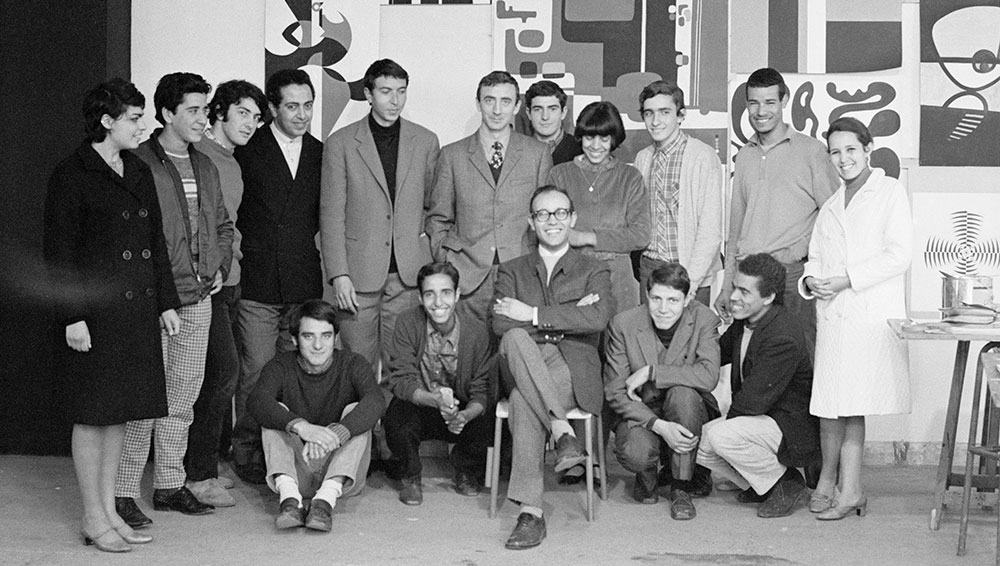
Farid Belkahia, Mohammed Chabâa and Mohamed Melehi surrounded by the students and their guest Augusto Bonalumi at the Casablanca Art School, 1966. Photo M. Melehi. © M. Melehi archives/estate.
Tate St Ives
27 May 2023 – 14 January 2024
by DAVID TRIGG
The trend for brightly coloured, hard-edged geometric painting that swept through the Casablanca Art School (CAS) in the late 1960s would have shocked the institution’s founders. Established as the École Municipale des Beaux-Arts de Casablanca in 1919, the school was still shaking off its roots in French-colonial ideology when the young Moroccan artist Farid Belkahia (1934-2014) became its director in 1962, six years after Morocco gained independence from France and Spain. Building on the programme of modernisation initiated by his predecessor, Maurice Arama, he assembled a radical faculty who rejected academic easel painting and orientalist figuration, embracing instead the interdisciplinary approach of the Bauhaus. Together, they reimagined the relationship between post-painterly abstraction and traditional Moroccan arts and crafts to create a local modernism that was nothing less than an artistic revolution.
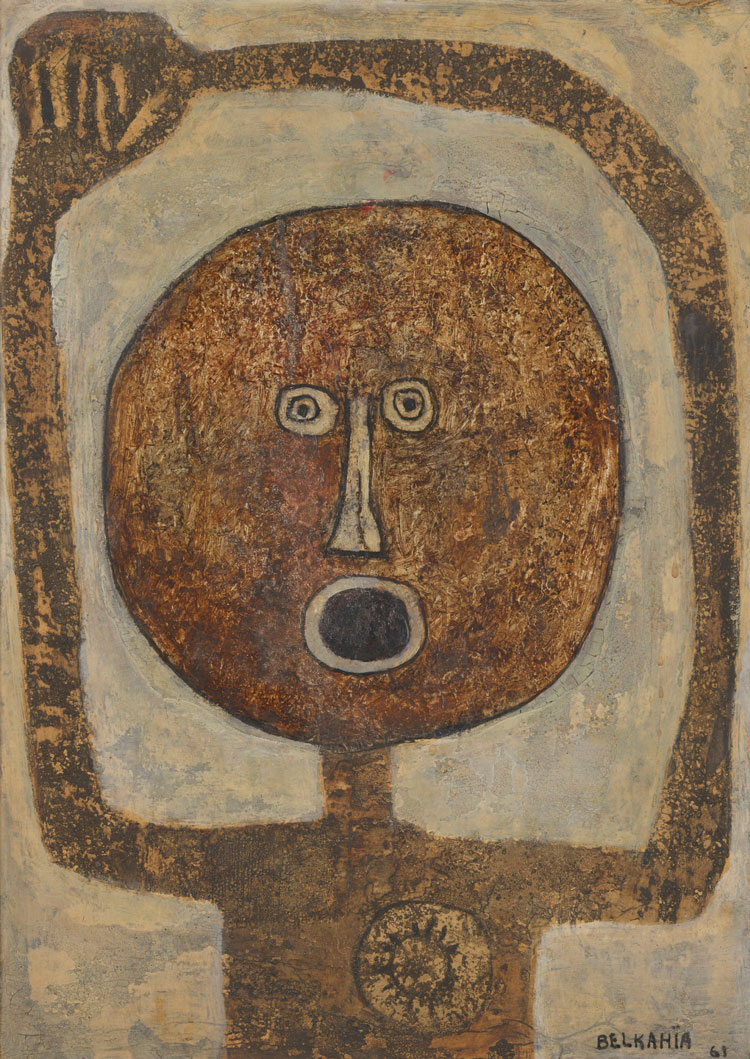
Farid Belkahia, Cuba Si, 1961. © Foundation Farid Belkahia. Tate Purchased with funds provided by the Middle East North Africa Acquisitions Committee 2016.
Belkahia’s early oil paintings responding to colonial regimes and international conflicts are among the handful of figurative works in this ambitious survey at Tate St Ives, the first museum exhibition dedicated to the CAS. The angry figure with its hands raised in his Cuba Si (1961) refers to the Bay of Pigs invasion of Cuba, while the limp, emaciated figure hanging upside down by one leg in Tortures (1961-62), expresses the artist’s outrage at French atrocities in the Algerian war of independence.
In 1964, Belkahia appointed Mohamed Melehi (1936-2020) as a painting tutor at CAS. He had been living and working in America, an experience that inspired the hard-edged, Barnett Newman-inflected canvas Minneapolis (1963), in which a horizontal sliver of grey and yellow divides a black rectangle from a larger expanse of red beneath it. Later, he embraced curved wave forms and vivid, luminous colours. When he arrived at CAS, he found “a rich and intense hub of artists”, who were “animated by the ambition to modernise and rethink the role of the artist in society”.1
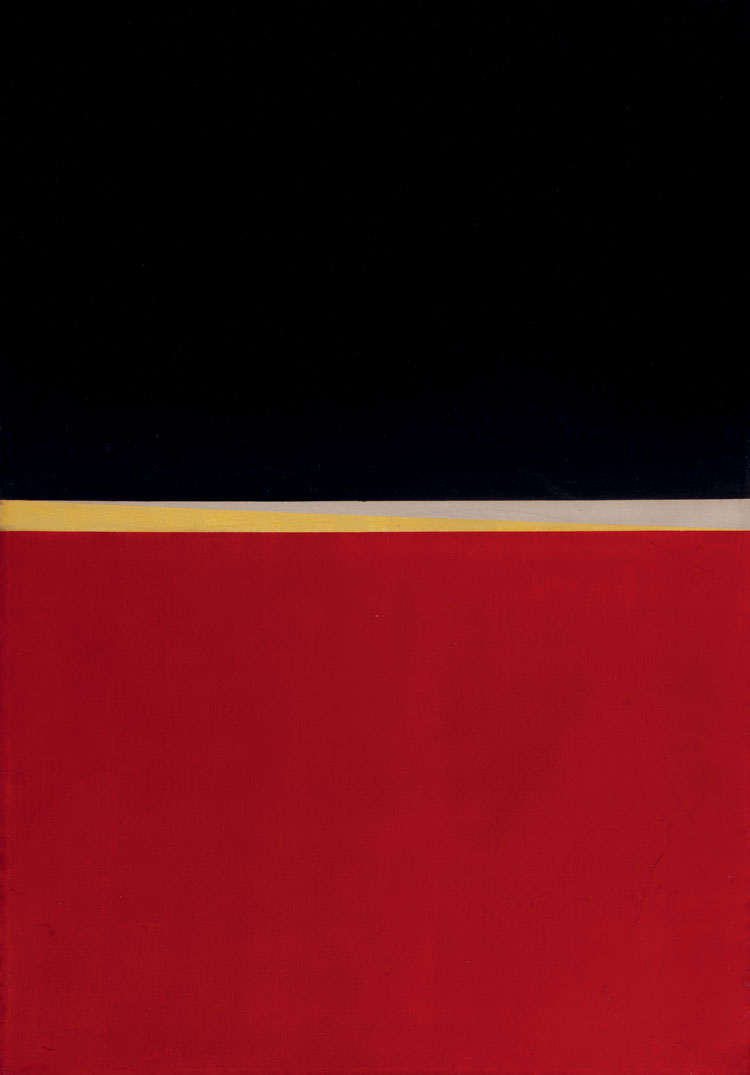
Mohamed Melehi, Minneapolis 1963. © Mohamed Melehi Estate. Courtesy of private collection, Marrakesh.
Melehi’s belief that art in Morocco was ready for transformation was shared by Belkahia as well as Mohammed Chabâa (1935-2013), who had been hired to teach graphic design at the school. The three artists, known informally as the Casablanca Trio, held their first joint exhibition in Rabat in 1966, presenting their work in the hall of the Mohammed V Theatre. By using this semi-public space, they declared their opposition to the state-organised “salon” exhibitions, which were notorious for sidelining and undermining the agency of Moroccan artists.
In 1969, they protested the French-founded Salon du Printemps (Spring Fair exhibition), which categorised Moroccan artists as “naive”. Joining with Mohamed Ataallah, Mustapha Hafid and Mohamed Hamidi, they organised the outdoor exhibition Présence Plastique, bringing their art directly on to the streets.

View of Plastic Presence manifesto exhibition, 16 November Square, Casablanca, June 1969. Photo: M. Melehi. © M. Melehi archives/estate.
Installing their dazzling abstract paintings and colourful murals in the public squares of Marrakech, they engaged people from all walks of life and every social class away from the rarefied environment of galleries and salons. As those associated with CAS increasingly reconsidered the social function of artists, such anti-elitist gestures became defining moments in the history of postcolonial Moroccan art and are now considered landmarks of modernist activity in the global south.
CAS staff members such as anthropologist Bert Flint encouraged a re-engagement with the traditional arts of Morocco. He researched in the High Atlas and Anti-Atlas mountains of Morocco, led classes on Arab, Amazigh, Islamic and Mediterranean heritage. Melehi was adamant that abstraction was not foreign to Morocco, but was, in fact, the true expression of north African art, being found in craft traditions that dated back centuries. In St Ives, a display of his photographs of Amazigh jewellery is exhibited alongside a large Amazigh rug and a carved wooden pillar, all of which feature geometric patterns and motifs that are echoed throughout the show, in paintings, drawings, prints, murals, posters, book covers and even interior design. Yet, with no attempt to contextualise these objects by explaining the original spiritual and social factors that led to their creation, we are left wondering what significance they had for Flint, Melehi and their students beyond an engagement with their formal qualities.
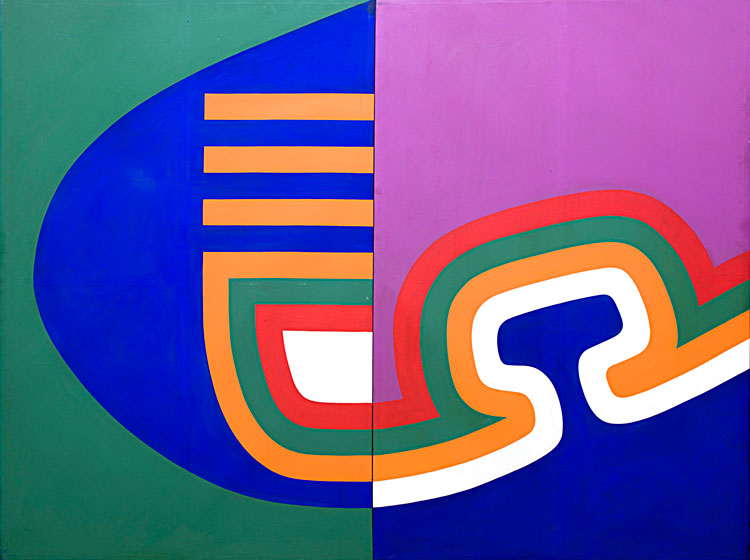
Mohammed Chabâa, Composition, 1975, Acrylic paint on media, 152 x 202 cm. Société Générale Maroc. © Chabâa Foundation.
In addition to bringing artworks on to the streets, CAS artists experimented with strikingly modern and dynamic graphic design to connect their work with public life. Chabâa was integral to this, teaching decoration, scenography and typography classes, and working with Melehi to co-design book covers, posters and logos that reflected their political commitments and support for Angolan and Palestinian resistance movements. They also designed the leftwing cultural journal Souffles, 16 issues of which are displayed here. Between 1966 and 1972, the journal aspired to decolonise and democratise Moroccan arts and culture until it was banned during the rule of King Hassan II, the “Years of Lead”, which were marked by the repression of political dissidents and activists. Chabâa himself was imprisoned for Marxist activism, as was the founder of Souffles, the poet Abdellatif Laâbi. This important part of the CAS story is, however, only briefly addressed.
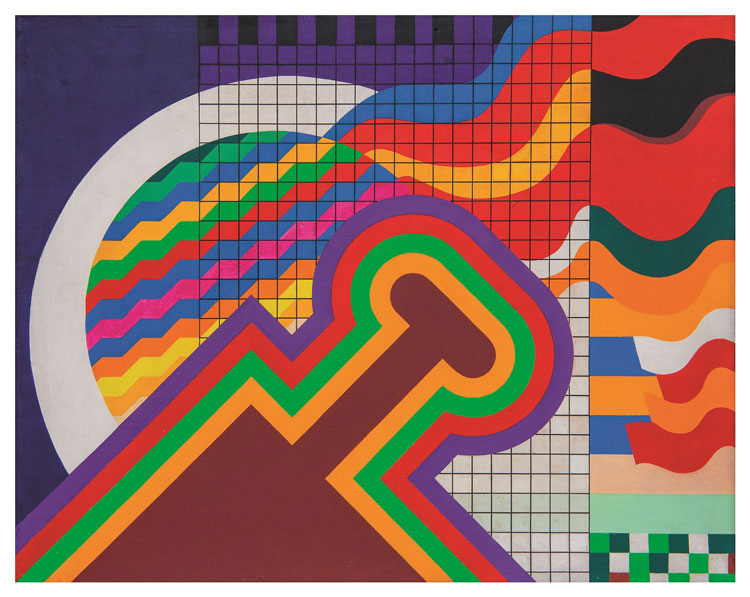
Mohammed Chabâa, Untitled, 1977. Acrylic on canvas. Tate collection. Photo: Fouad Mazouz.
Belkahia left the CAS in 1974, the year of the first pan-Arab Biennial at Baghdad’s Museum of Modern Art in Iraq. He curated the exhibition’s Moroccan delegation, which included 14 artists associated with the school. Their bold and vivid works pointed to the country as the centre of a dynamic new wave in Arab art, so much so that CAS artists were invited to organise the second edition of the biennial in Rabat in 1977, which further spread their vision. In a room of works from this period, Chabâa’s complex configuration of angled lines, uniform grids and undulating waves in Untitled (1977) contrast with Melehi’s elegantly minimal Flamme (1976).
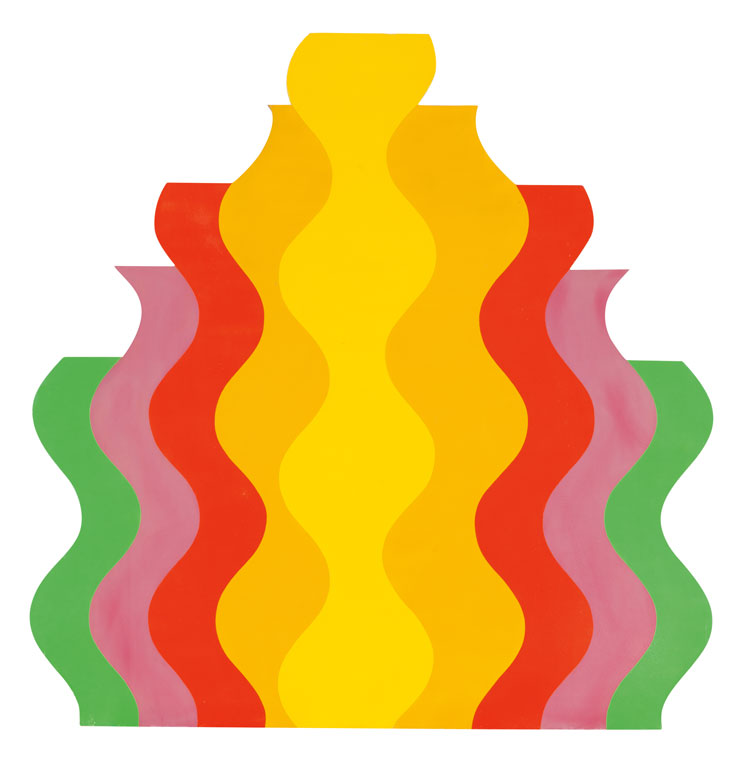
Mohamed Melehi, Flamme, 1976. Private collection.
The influence of both artists is seen in Abdelkrim Ghattas’ colourful Composition (1977), in which a horizontal band of busy interlocking geometric shapes is balanced with vertical stripes and a green monochrome background.
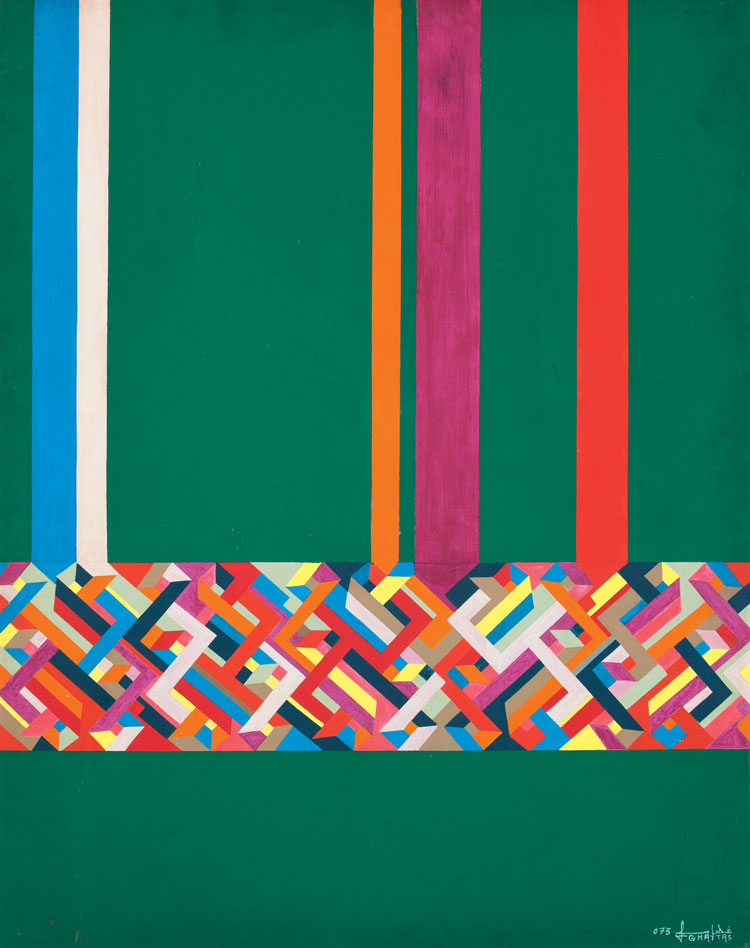
Abdelkrim Ghattas, Composition, 1977. Private collection.
In 1978, Melehi and Mohamed Benaïssa co-founded the Asilah Festival, which continued the Casablanca artists’ democratising mission by bringing contemporary art directly to the community through street exhibitions and murals. The annual festival gave a platform to numerous artists, including those overlooked by the mainstream such as the self-taught painter Chaïbia Talal. She was once dismissed as a “naive” artist and her large, exuberant La Cérémonie du Mariage (1983) closes the show with its colourful evocation of a jubilant wedding party. It is another example of how those associated with the CAS challenged and reimagined what modern art in postcolonial Morocco could be – a legacy whose impact endures to this day.
Reference
1. Mohamed Melehi in conversation with Morad Montazami, Third Text, 12 February 2021.